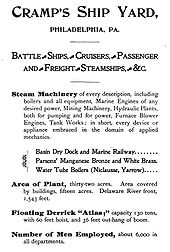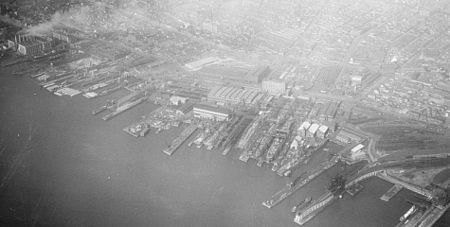- William Cramp and Sons
-
- not to be confused with Cramp & Co., builder of schools in Philadephia
William Cramp & Sons Shipbuilding Company of Philadelphia was founded in 1825 by William Cramp, and was the preeminent U.S. iron shipbuilder in the 19th century. The American Ship & Commerce Corporation bought the yard in 1919 but closed it in 1927 as fewer ships were ordered by the U.S. Navy after passage of the Naval Limitations Treaty in 1923.
In 1940, the Navy spent $22 million to reopen the yard to build cruisers and submarines. Cramp used the long slipways to construct two submarines at a time, with the intention of launching them simultaneously. However, the shipyard's submarine construction program not especially successful, as poor management hindered the delivery of the boats.[1] The first delivery was made two years after keel laying, and fitting out was then done by Portsmouth Navy Yard. The best construction time for a submarine was 644 days.[2]
Cramp closed in 1947 and the site, on the Delaware River, became an industrial park.
Notable projects
- USS Indiana (BB-1), Battleship No. 1 of the United States Navy, launched 28 February 1893.
- SS St. Louis (1894) and SS St. Paul (1895) -- the first major ocean liners built in the United States after the collapse of the Collins Line in the 1850s. On 15 November 1899, St. Paul, enroute from New York to England with Guglielmo Marconi on board supervising the ship's new wireless telegraph equipment, became the first liner to report her imminent arrival by radio.
- Varyag contracted by Russian Imperial Admiralty, launched October 31, 1899. The cruiser was sunk by the crew in Russo-Japanese War, salvaged by the Japanese and then reclaimed by the Russians.
- On 8 December 1942, the keel to the Cleveland-class light cruiser designated CL-91, was laid down by the Cramp Shipbuilding Company of Philadelphia, PA. On 22 April 1943, Oklahomans were outraged, having just learned that the Japanese had executed the captured American pilots from Jimmy Doolittle's bombing raid over Tokyo. That same day, booths were set up in Oklahoma City with the a goal to sell $40 million in War Bonds to fund the construction of a cruiser. That goal was topped by $5 million when the booths closed that night. CL-91 then became the USS Oklahoma City.
- The last ship Cramp's built was the cruiser USS Galveston (CLG-3), launched on April 22, 1945.
Works of the firm that are listed on the U.S. National Register of Historic Places include:
- SS ALEUTIAN (Shipwreck), Address Restricted, Larsen Bay, AK (Cramp, S. and Sons S&EB Company), NRHP-listed in Kodiak Island Borough, Alaska[3]
- U.S.S. LING, Hackensack River at 150 River St., Hackensack, NJ (Cramp,William & Sons), NRHP-listed[3]
- USS LIONFISH (SS0298), National Historic Landmark, Battleship Cove, Fall River, MA (Cramp Shipbuilding Corp.), NRHP-listed[3]
- USS MASSACHUSETTS--BB-2 (shipwreck), 1. mi. SSW of Pensacola Pass, Pensacola, FL (William Cramp & Sons), NRHP-listed[3]
See also
- Delaware River
- Philadelphia Naval Shipyard
- Lewis Nixon and Arthur Leopold Busch, naval architects who worked with Cramp & Sons.
Coordinates: 39°58′19.34″N 75°7′4.13″W / 39.9720389°N 75.1178139°W
References
- ^ Stefan Terzibaschitsch, Submarines of the US Navy, Arms and Armour Press, 1991. p.70, 71
- ^ Terzibaschitsch, p.70, 71
- ^ a b c d "National Register Information System". National Register of Historic Places. National Park Service. 2009-03-13. http://nrhp.focus.nps.gov/natreg/docs/All_Data.html.
- "William Cramp & Sons Shipbuilding Company". GlobalSecurity.org. http://www.globalsecurity.org/military/facility/cramp.htm. Retrieved 2007-04-29.
- "Cramp & Sons". Builders. Destroyer History Foundation. 2007. http://www.destroyerhistory.org/destroyers/cramp.html. Retrieved 2007-11-05.
Categories:- Companies based in Philadelphia, Pennsylvania
- Defunct shipbuilding companies of the United States
- Defunct companies based in Pennsylvania
- 1825 establishments in the United States
- Companies established in 1825
- Companies disestablished in 1947
Wikimedia Foundation. 2010.


